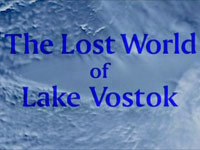The Lost World Of Lake Vostok
Zdá se, že lidé prozkoumali už každý kout naší planety. Země si však některá svá tajemství ještě ponechává. Jedno z nich je ukryto čtyři kilometry pod ledovým příkrovem Antarktidy. V roce 1957 byla v jihovýchodní části "šestého kontinentu" založena sovětská polární stanice Vostok. Měřením ledového příkrovu byl tehdy pověřen mladý vědec Andrej Kapica. Při letech nad okolím základny si povšiml, že povrch ledovce je až neobvykle rovný.
Vyslovil zájímavou hypotézu, kterou však jeho kolegové považovali za absurdní. Podle Kapicy totiž mělo být pod povrchem obrovské jezero. V roce 1974 prováděla letecký výzkum britská polární výprava. Pomocí radaru zpozorovali britští glaciologové pod podložím ledovce velkou rovnou plochu. Došli k závěru, že se jedná o obrovskou vodní plochu. Definitivní potvrzení Kapicovy teorie však přinesly až satelitní průzkumy na konci XX. století.
Potvrdily, že pod čtyřmi kilometry ledu se na 14 000 kilometrech čtverečních rozkládá jedno z největších jezer na zeměkouli. Vzniklo patrně před třiceti miliony let, v době, kdy v Antarktidě bylo ještě mírné podnebí. A asi před patnácti miliony let se nad ním v důsledku klimatických změn utvořil dnešní antarktický ledovec. Vody jezera mohou skrývat mnoho důkazů o tom, jak život na naší planetě vypadal dávno předtím, než se na Zemi objevilil první lidé.
To je důvod, proč Vostok láká vědce nejrůznějších profesí. V současné době vrcholí přípravné práce mezinárodního projektu. Jeho cílem je dokončení vrtu, který pronikne až k hladině jezera, a spuštění miniponorky, jež probádá obsah této "obří zkumavky" neprodyšně uzavřené už miliony let.
Drilling the Ice from the Past to the Future
VideoLectures.Net Jozef Stefan Institute colloquia
View the
complete series
Speaker: Alexey A. Ekaykin - Arctic and Antarctic Research Institute, Russian Federal Service for Hydrometeorology and Environmental Monitoring
License: Creative Commons CC BY-NC-ND 3.0
More information,
More talks
On the 5th of February 2012 the hardened hands of drill masters turned a new page of the chronicle of the Antarctic exploration. In the heart of the snow desert at Russian Vostok Station, the head of a boring machine pierced the glacier to touch the water of the huge lake that had been hidden under 4 km of ice for millions of years. A long way led to this event, full of mystery, tragedy, disappointment and luck. An overview of Russian activities with focus on deep ice drilling at Vostok Station and the investigations of the subglacial Lake Vostok will be presented.
How the Lake was discovered? Why is it important to explore it? What do we know about the Lake now? What shall we know after penetrating it? These and other questions will be addressed here. In addition, the climatic record over the past 420.000 years, as the main achievement of the Vostok deep ice coring, will be shortly discussed. Finally, the drilling operations that were carried out during the last summer expedition from November 2011 to February 2012 will be shown and some unique materials will be for the first time presented to the public to demonstrate the moment of the penetration to the Lake.
0:00 Drilling the Ice from the Past to the Future
2:39 Fortune favors the brave (1)
3:25 Fortune favors the brave (3)
4:04 Russian Antarctic stations
6:43 Vostok
7:46 Vostok Station
8:32 1970: beginning of the deep drilling
8:57 Deep ice drilling to study the remote past
11:02 "Cornucopia of paleoclimatic data" (1)
12:40 "Cornucopia of paleoclimatic data" (2)
13:12 Lake Vostok
13:52 Can melt-water exist under deeply frozen Antarctic glacier?
15:10 Byrd Station, 2164 m (29 January 1968)
16:22 Andrey Kapitsa (1931-2011)
17:14 Gordon de Q. Robin, 1970s - Ridley et al., 1993
18:45 Lake Vostok: The 5th largest lake in the world! (1)
18:51 Lake Vostok: The 5th largest lake in the world! (2)
19:19 Aquatic environments beneath the Antarctic ice sheet
20:09 Subglacial river
20:22 Dry Valleys
20:47 Why Lake Vostok?
22:12 From 5G-1 to 5G-2
23:39 What do we know about the Lake Vostok?
VoR's Culture Review of the Year
In the first of a series of four, VoR's Alice Lagnado looks back at some of VoR's most popular exclusive features of 2013. One tale that clearly captured the imagination of many was her meeting with one of the team of Russian scientists from St Petersburg who penetrated the sub-glacial Lake Vostok in Antarctica, which has been isolated for 14 million years and may contain new forms of life.
Spare a thought for the scientists working away in freezing and very basic conditions as you enjoy Christmas -- they do celebrate New Year but the food isn't exactly gourmet.
But it's not altogether without romance at the Vostok research station -- according to tradition, every third toast is drunk to love.
Listen to the audio above to enjoy a story about the science behind the Lake Vostok drilling with Dr Alexey Ekaykin, as well as an in-depth interview with Professor Nikolai Vasiliev, the head driller, who's dedicated his life to finding ways to drill through four miles of ice.
More info.
